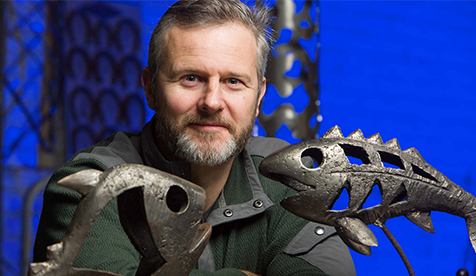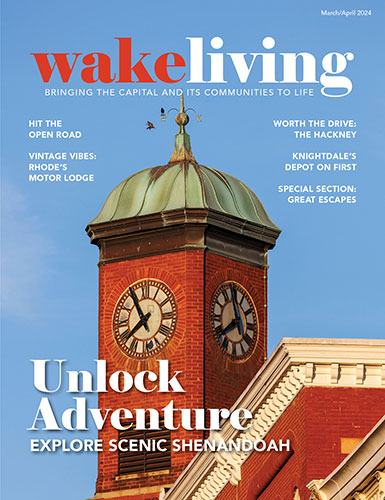When thinking about outdoor activities, looking at sculpture is likely not the first thing that comes to mind.
But local advocates of public art invite you to think again.
“If things are out in public, they are a little more accessible; maybe you can touch it,” said Catherine J. Howard, executive director of Cary Visual Art. “Sculptures that have interesting textures are a great incentive and invitation to engage with the work physically. Many of the sculptors I know wholeheartedly want kids to climb on it, to touch it, to crawl through it — to engage with it. That’s what makes the work alive. Outdoor sculpture can be so alive.”

At his studio space at Liberty Arts in Durham, Christian Vagn Hansen is surrounded by works in progress and bits of scavenged metal that will go into future projects.
Cary sculptor Christian Vagn Hansen agrees.
“People should be interacting with sculpture,” he said. “Sometimes people are intimidated by sculpture, but standing and looking at the piece isn’t the total experience.”
Hansen and Phil Hathcock, another Cary sculptor, have had their work featured in the juried Cary Visual Art’s annual Outdoor Sculpture Exhibition — Hathcock in 2014 and 2015, Hansen in 2013 and 2014. And each relishes that moment when initial puzzlement turns to understanding.
“When people interact with art, it expands their mind, their horizons,” said Hathcock. “I think it opens up a whole world for people who just see shopping malls, cars and traffic — and then they see this piece. Whether they like it or not, it really doesn’t matter.”
“I like making things that people have to stop, look at and figure out a little bit,” said Hansen.

In his Durham studio, Hansen uses a variety of techniques — heating, pounding and grinding — to shape metal into forms inspired by nature. “Trying to create natural, rounded forms in metal is a challenge,” he admits.
Although different in their approaches, both Hathcock and Hansen draw inspiration from the natural world. So their work, in particular, seems at home in an outdoor setting.
Christian Vagn Hansen
Although he has drawn and painted since he was a child, Hansen didn’t start making sculpture until five years ago. A neighbor talked him into attending an informal metal-working event in Moncure, N.C., led by Kevin Eichner, sculptor and art director at the Moncure Museum of Art.
“All of a sudden I was in love with building something of a permanent nature,” said Hansen.
He learned to weld and manipulate metal, and has since participated in castings, in which artists catch molten ore in sand molds. He still works primarily in metal, although that is not his only medium.
“Material isn’t what drives me, not metal for the sake of metal,” he said. “It’s all about the finished product. I use whatever is the best material for the piece.”

Hansen owns Abodia, a property management firm, and spends his spare time at his Liberty Arts studio space in Durham. He calls the environment “a great facility to explore things,” and appreciates that he can ask his fellow artists for help with thorny issues.
“Much of my inspiration comes from nature — seeds and pods,” he said. “Nature is the best builder, plus it’s aesthetically pleasing in its design and natural architecture. Although trying to create natural, rounded forms in metal is a challenge.”
He describes muscling a metal rod into a complex s-curve to suggest the gentle slope of a seed pod. Nearby, a huge abstract flower dips low on a graceful stem, its head comprised of many smaller parts, bringing to mind a dandelion seed head or hydrangea bloom.
“The larger pieces are more about the overall feeling they give,” Hansen said. “They are abstract in nature, but somehow familiar. The smaller, more whimsical pieces have to have something that catches someone’s eye. They still have to have that certain elegance. I look at a picture of a real bird, and the shape of the neck brings the idea of a bird to mind.”
He attributes his fascination with sleek, efficient forms to his Danish parents and the Scandinavian furnishings of his childhood home.

Left: In his outdoor workspace in Cary, Phil Hathcock arranges stones, wood and metal into intriguing sculptures. “We try to manipulate the stone no more than we have to to get the point across,” he says.
Right: Hansen’s “Harlequin” was part of the 2014-2015 CVA Outdoor Sculpture Exhibition. It is now on display in Chapel Hill.
“I want to create an effect with as little as possible,” he said. “There’s a certain elegance to creating an impression with as few pieces as possible.”
Phil Hathcock
A self-taught artist, Hathcock has worked with stone all his life. For years he and his father sold stone for construction and landscaping. Now Hathcock owns Natural Stone Sculptures, a Cary landscaping business that specializes in Japanese-style gardens.
“The landscape work we do is closely intertwined; even the hobbies that I do are closely intertwined with the work I do,” he said. “It’s pretty much a life of art and nature.”
In his spare time Hathcock enjoys hiking along riverbeds, searching for fossils, gemstones, and Native American artifacts of all kinds, especially carved arrowheads and stone tools. He is inspired by the skillful shaping of one stone with another.

Phil Hathcock has worked with stone all his life, and now owns Natural Stone Sculptures, a Cary landscaping business that specializes in Japanese-style gardens. His business and his hobbies are intertwined. “It’s pretty much a life of art and nature,” he says.
This love for nature aligns with his appreciation of Eastern design. Hathcock says he is inspired by the work of Isamu Noguchi, a sculptor, furniture designer and landscape architect who was one of the first to use the natural shape of stones in his work.
“I work with the stone as little as possible,” said Hathcock. “We’ll go to quarries in western North Carolina and we may look through a million tons of big stones that are the waste product of quarrying for stone flooring. We look through them to pick out one that might be a set of wings for a butterfly.”
Once he finds that one stone in a million, he and his assistant will haul it back to the open-air studio. He will assess the rock, moving it around, pairing it with other stones, or adding metal to enhance its shape or display it to the best effect.

Importance of public art
Hathcock’s piece “Windstone,” constructed of slate, aluminum, copper and brass, will be on display in downtown Cary until June 17. The CVA invites the public to come out and experience this and other sculptures, placed along Academy Street.
“Since public art is often a surprise — you just run across it — it really helps you to open your eyes and see a little bit more of what is happening around you,” said Howard, of CVA.
Both artists appreciate the opportunity to have their work displayed in the community.


Phil Hathcock and his team install his sculpture, “Windstone,” in downtown Cary in July. The piece, constructed of slate, aluminum, copper and brass, will be on display until June 17.
“I give CVA a lot of credit for creating opportunities for artists and to the town for its support of public art,” said Hansen. “It’s great seeing people’s reaction to the art.”
When art is in public spaces, more people have a chance to interact with it, they say.
“It’s more about getting something natural and beautiful out for people to enjoy,” said Hathcock. “In art, it’s definitely not about the money. It’s just about letting people enjoy it.”
 |
 |
 |
 |
 |
 |
 |
 |
 |






